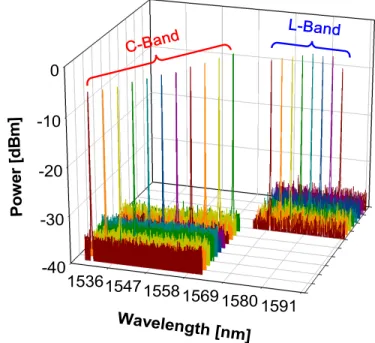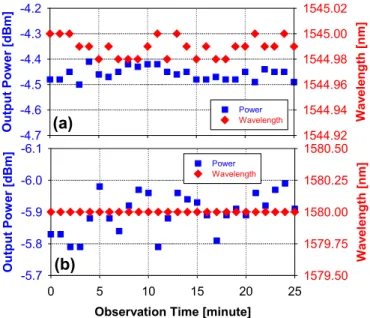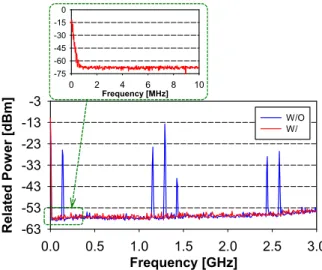Stable and wavelength- selectable C + L band
fiber ring laser with single-longitudinal-mode
by utilizing C-band erbium fiber amplifier
C
HIEN-H
UNGY
EH,
1,*Y
UAN-H
ONGZ
HUANG,
1N
INGT
SAI,
1ANDC
HI-W
AIC
HOW21Department of Photonics, Feng Chia University, Taichung 40724, Taiwan
2Department of Photonics and Institute of Electro-Optical Engineering, National Chiao Tung
University, Hsinchu 30010, Taiwan
*yehch@fcu.edu.tw
Abstract: In the investigation, we propose and demonstrate a wavelength-selectable C- plus L-band erbium-doped fiber (EDF) ring laser with single-longitudinal-mode (SLM) output. Here, a C-band erbium-doped fiber amplifier (EDFA) is utilized to serve as gain medium together with proposed multi-cross-ring (MCR) scheme to extend the wavelength tunability to L-band range. Besides, the MCR can also suppress the multi-longitudinal-mode (MLM) significantly. Therefore, the measured output power and optical signal to noise ratio (OSNR) of each lasing wavelength are between −10.1 and −2.7 dBm, and 26.4 and 35.0 dB/0.06 nm, respectively in the wavelength range from 1530.0 to 1584.0 nm. In addition, the output stabilities of power and wavelength in the proposed EDF MCR laser have been also analyzed experimentally.
© 2017 Optical Society of America
OCIS codes: (060.3510) Lasers, fiber; (140.3500) Lasers, erbium; (140.3600) Lasers, tunable. References and links
1. B. Yin, Z. Liu, S. Feng, Y. Bai, H. Li, and S. Jian, “Stable single-polarization single-longitudinal-mode linear cavity erbium-doped fiber laser based on structured chirped fiber Bragg grating,” Appl. Opt. 54(1), 6–11 (2015). 2. S.-K. Liaw, Y.-W. Lee, H.-W. Huang, and W.-F. Wu, “Multi-wavelength linear-cavity SOA-based laser array
for long-haul sensing,” IEEE Sens. J. 15(6), 3353–3358 (2015).
3. M.-C. Amann, “Phase noise limited resolution of coherent LIDAR using widely tunable laser diodes,” Electron. Lett. 28(18), 1694–1696 (1992).
4. C.-H. Yeh, C.-C. Lee, and S. Chi, “A tunable S-Band erbium-doped fiber ring laser,” IEEE Photonics Technol. Lett. 15(8), 1503–1504 (2003).
5. Y. Yao, X. Chen, Y. Dai, and S. Xie, “Dual-wavelength erbium-doped fiber laser with a simple linear cavity and its application in microwave generation,” IEEE Photonics Technol. Lett. 18(1), 187–189 (2006).
6. C.-H. Yeh, M.-C. Lin, and S. Chi, “A tunable erbium-doped fiber ring laser with power-equalized output,” Opt. Express 14(26), 12828–12831 (2006).
7. A. K. Atieh and S. Tchouragoulov, “Subpicosecond soliton pulse generation in the L-band using passive mode-locked figure-eight fiber laser,” in Proc. of CLEO (2000), pp. 261−262.
8. C.-H. Yeh, C.-C. Lee, and S. Chi, “120-nm bandwidth erbium-doped fiber amplifier module in parallel configuration,” IEEE Photonics Technol. Lett. 16(7), 1637–1639 (2004).
9. V. R. Supradeepa, J. W. Nichsolson, C. E. Headley, M. F. Yan, B. Palsdottir, and D. Jakobsen, “A high efficiency architecture for cascaded Raman fiber lasers,” Opt. Express 21(6), 7148–7155 (2013).
10. C. H. Yeh and C. W. Chow, “Broadband wavelength-tunable single-longitudinal-mode erbium-doped fiber ring laser using saturable-absorber filter,” Laser Phys. Lett. 7(2), 158–163 (2010).
11. S. Yamashita and M. Nishihara, “Widely tunable erbium-doped fiber ring laser covering both C-band and L-band,” IEEE J. Sel. Quantum Electron. 7(1), 41–43 (2001).
12. M. Y. Jeon, N. Kim, J. Shin, J. S. Jeong, S.-P. Han, C. W. Lee, Y. A. Leem, D.-S. Yee, H. S. Chun, and K. H. Park, “Widely tunable dual-wavelength Er3+-doped fiber laser for tunable continuous-wave terahertz radiation,” Opt. Express 18(12), 12291–12297 (2010).
13. C. H. Yeh, C. W. Chow, Y. F. Wu, Y. H. Lin, B. C. Cheng, and J. H. Chen, “Using optimal cavity loss and saturable-absorber passive filter for stable and tunable dual-wavelength erbium fiber laser in single-longitudinal-mode operation,” Laser Phys. Lett. 8(9), 672–677 (2011).
#290769 https://doi.org/10.1364/OE.25.021019
14. T. Feng, F. Yan, S. Liu, Y. Bai, W. Peng, and S. Tan, “Switchable and tunable dual-wavelength single-longitudinal-mode erbium-doped fiber laser with special subring-cavity and superimposed fiber Bragg gratings,” Laser Phys. Lett. 11(12), 125106 (2014).
15. X. Chen, J. Yao, and Z. Deng, “Ultranarrow dual-transmission-band fiber Bragg grating filter and its application in a dual-wavelength single-longitudinal-mode fiber ring laser,” Opt. Lett. 30(16), 2068–2070 (2005).
16. X. Liu, X. Yang, F. Lu, J. Ng, X. Zhou, and C. Lu, “Stable and uniform dual-wavelength erbium-doped fiber laser based on fiber Bragg gratings and photonic crystal fiber,” Opt. Express 13(1), 142–147 (2005).
17. P.-C. Peng, K.-M. Feng, W.-R. Peng, H.-Y. Chiou, C.-C. Chang, and S. Chi, “Long-distance fiber grating sensor system using a fiber ring laser with EDWA and SOA,” Opt. Commun. 252(1-3), 127–131 (2005).
1. Introduction
Recently, broadband and wavelength-tunable erbium-doped fiber (EDF)-based lasers with stable output play the main roles in different applications, such as wavelength-division-multiplexing (WDM) communication system [1], optical sensing system [2], light detection and ranging (LIDAR) [3], instruments testing [4], and microwave photonics [5] etc. The erbium-doped fiber amplifiers (EDFAs) are utilized commonly to serve as gain medium in different fiber lasers [6]. However, the gain profile of typical erbium-doped fiber amplifier (EDFA) is in C-band (1525 to 1565 nm). In order to achieve widely operation bandwidth of EDF laser, the S- (1480 to 1520 nm) or L-band (1560 to 1610 nm) EDFAs should be applied inside a cavity [7, 8]. In general, to achieve wavelength-selectable C- plus L-band fiber laser, using hybrid optical amplifier, Raman amplifier (RA) and broadband EDFA inside a cavity have been proposed and studied [9–11]. Although these proposed researches can achieve C- to L-band operation, but they still require widely gain-band amplifier for providing wavelength tunability.
Due to the mode-hoping and homogeneous broadening in EDF, unstable and multi-longitudinal-mode (MLM) output will occur. Hence, to obtain stable single-longitudinal-mode (SLM) operation, several techniques have been proposed, such as using self-injection method [12], employing unpumped EDF-based saturable-absorber-filter [13], utilizing multiple-ring configuration [14] and applying narrow band optical filter [15].
In the investigation, we first demonstrate using conventional C-band EDFA and multi-cross-ring (MCR) scheme to achieve C- plus L-band wavelength-selectable EDF laser together with stable SLM output. Here, the proposed MCR scheme not only can extend the tuning range to L-band, but also can serve as ring filter to suppress the densely MLM. To evaluate the output characteristics of proposed EDF laser, the output power, optical signal to noise ratio (OSNR), and side-mode suppression ratio (SMSR) of each lasing wavelength are also measured and analyzed in the operated range of 1530.0 to 1584.0 nm. In addition, we also perform the stability assessments in terms of output wavelength and power.
2. Experiment and results
Figure 1(a) presents the experimental setup of proposed wavelength-selectable EDF ring laser scheme. The proposed EDF ring laser is consisted of two polarization controllers (PCs), a polarizer (POL), an optical tunable bandpass filter (OTBF), a 1 × 2 and 10:90 optical coupler (OCP1), a C-band commercial EDFA, and a multi-cross-ring (MCR) configuration. In the
measurement, the C-band and L-band OTBFs are utilized to generate and vary different wavelength output, respectively. The tuning ranges of C- and L-band OTBFs are between 1530.0 and 1560.0 nm and 1570.0 and 1610.0 nm respectively. The insertion loss and 3 dB bandwidth of two OTBFs are 6 dB and 0.4 nm. In this measurement, there is a 8-nm frequency gap which cannot be tuned due to the limited tuning ranges of the two OTBFs. To enhance the stability of the lasing wavelength, the nonlinear polarization rotation (NPR) can be introduced to the fiber cavity [16]. Hence, the NPR effect would generate the intensity-dependent inhomogeneous loss. Here, two PCs and a POL are used to produce the NPR effect, as illustrated in Fig. 1(a), for maintaining the polarization status and obtaining maximum output power. The lasing wavelength can be observed in the 10% output port of
OCP1. In the experiment, an optical spectrum analyzer (OSA) with a 0.06 nm resolution is
employed for observation and measurement.
As shown in Fig. 1(a), the MCR is constructed by three 2 × 2 and 50:50 OCPs2. The MCR
can produce three fiber rings. Besides, there is also a main fiber ring in the proposed EDF laser architecture, as illustrated in Fig. 1(a). Therefore, total four fiber rings can produce their corresponding free spectrum range (FSR). Hence, when the FSR of each fiber ring can satisfy the least common multiple based on the Vernier validity [14], the densely multi-longitudinal-mode (MLM) of lasing wavelength can be suppressed significantly. Moreover, the proposed MCR structure and NPR effect can spread the operated range from C-band to L-band in the experiment. EDFA PC PC POL OTBF OCP1 OCP2 OCP2 OCP2 10% 90% OSA / ESA Multi-Cro ss-Rin g (MCR) Wavelength [nm] 1525 1530 1535 1540 1545 1550 1555 1560 Pow er [dBm ] -30 -24 -18 -12 -6 Ga in [dB] 19 23 27 31 35 ASE Gain (a) (b)
Fig. 1. (a) Proposed C- plus L-band wavelength-tunable EDF ring laser architecture. (b) Observed amplified spontaneous emission (ASE) spectrum and gain profile of C-band EDFA.
-40 -30 -20 -10 0 1536154715581569 1580 1591 P o w er [ d B m] Wavelength [nm]
Fig. 2. Measured output wavelength spectra of proposed EDF MCR laser covering both C- and L-band.
The C-band EDFA is employed to act as a gain medium inside the proposed fiber ring laser architecture. Figure 1(b) presents the measured amplified spontaneous emission (ASE) spectrum and gain profile of commercial C-band EDFA. The maximum ASE power is around 1530 nm in C-band range of 1525.0 to 1560.0 nm. Besides, the obtained gain profile is between 20.0 and 31.5 dB when the input signal power is −10 dBm.
When the two OTBFs are tuned arbitrarily inside a cavity loop respectively, then each different output wavelength can be generated. Figure 2 shows the measured output wavelength spectra of proposed EDF MCR laser, while the C-band and L-band OTBFs are used, respectively. Thus, we can observe different lasing wavelengths in the operated range 1530.0 to 1584.0 nm covering C-band and L-band. As depicted in Fig. 2, the background ASE noise of EDFA can be suppressed completely. Besides, according to the proposed EDF laser scheme, the tuning optical signal can stretch to a longer wavelength range. However, when the passband of OTBF is tuned over the wavelength of 1585.0 nm, the output wavelength cannot generate due to the insufficient gain. According to the previous work [17], to achieve high gain and widely operated bandwidth for fiber ring laser, Peng et al. proposed using the hybrid erbium-doped waveguide amplifier (EDWA) and semiconductor optical amplifier (SOA) for wavelength tuning. However, the hybrid amplifier serving as gain medium would increase the cost and noise figure. Hence, the proposed stable SLM EDF ring laser with the MCR configuration and C-band EDFA to achieve C + L band tuning range is simple and cost-effective.
Wavelength [nm] 1525 1533 1541 1549 1557 1565 1573 1581 1589 Output Pow er [d B m ] -12 -9 -6 -3 0 OSN R / SM SR [dB] 0 10 20 30 40 Power OSNR SMSR
Fig. 3. Measured output power, OSNR and SMSR of proposed EDF MCR laser covering both C- and L-band ranges.
Figure 3 displays the observed output power, OSNR and side-mode suppression ratio (SMSR) of proposed EDF MCR laser covering both C- and L-band ranges. As illustrated in Fig. 3, there is 8.0 nm band gap of 1561.0 nm 1569.0 nm cannot be measured owing to the device limitation of two OTBFs. The output powers of −10.1 to −2.8 dBm are observed in the wavelengths of 1530.0 to 1584.0 nm. The measured output powers are drop gradually in wavelengths at both sides due to the insufficient gain of the EDF. Moreover, the measured OSNR and SMSR are between 26.4 and 35.0 dB/0.06 nm; and 23.7 and 32.0 dB/0.06 nm, respectively, as schemed in Fig. 3. The maximum output power is obtained at the wavelength of 1560.0 nm together with the OSNR and SMSR of 33.6 dB/0.06 nm and 32.0 dB/0.06 dB. In the proposed EDF ring laser architecture, the measured maximum tuning range is from 1530.0 to 1584.0 nm, due to the limit of OTBF component. However, according to the output distribution of Fig. 3, the wavelength range may start from 1525.0 nm when a properly optical filter is utilized. Probably, the proposed EDF ring laser could reach the operation bandwidth of nearly 60 nm.
Then, to understand the output stability of proposed EDF MCR laser scheme, a short-term observation of output power and wavelength is performed experimentally. In the measurement, initially, the lasing wavelengths of 1545.0 nm and 1580.0 nm with output powers of −4.5 and −5.8 dBm are employed to demonstration, respectively, when the C- and L-band OTBFs are applied for tuning. Figures 4(a) and 4(b) present the measured stability performances of output power and wavelength in a 25 minutes observing time, respectively, when the lasing wavelengths are selected at 1545.0 (C-band) and 1580.0 nm (L-band). As seen in Figs. 4(a) and 4(b), the observed output power fluctuations and lasing wavelength variations of 1545.0 nm and 1580.0 nm are 0.1 and 0.2 dB; and 0.02 and 0.00 nm, respectively. As a result, a high output stability of proposed EDF MCR laser is achieved based on the measurement results. In addition, during one hour observation time, the obtained stability performance of power and wavelength are still maintained within the observed differences as mentioned above.
Output Pow er [dBm ] -4.7 -4.6 -4.5 -4.4 -4.3 -4.2 Wa ve le ngth [nm] 1544.92 1544.94 1544.96 1544.98 1545.00 1545.02 Power Wavelength
Observation Time [minute]
0 5 10 15 20 25 Ou tp ut Pow er [dBm] -6.1 -6.0 -5.9 -5.8 -5.7 Wa ve le n g th [ n m ] 1579.50 1579.75 1580.00 1580.25 1580.50 Power Wavelength (a) (b)
Fig. 4. Measured stability performances of output power and wavelength in a 25 minutes observing time, respectively, when the lasing wavelengths are selected at (a) 1545.0 nm and (b) 1580.0 nm.
Finally, to realize the SLM performance of each lasing wavelength in the proposed EDF MCR laser, a delayed self-homodyne measurement is performed experimentally. The optical setup is constructed by a Mach-Zehnder interferometer (MZI), having 25 km single-mode fiber (SMF), a PC and a 10 GHz PIN-based receiver (Rx). Beside, we also choose a lasing wavelength of 1545.0 nm initially for SLM measurement. Here, a 3 GHz bandwidth electrical spectrum analyzer (ESA) is used to detect the converted electrical signal from Rx. Figure 5 shows the observed electrical spectra of proposed EDF ring laser with (red line) and without MCR structure (blue line) in a measured frequency bandwidth of 3 GHz. Essentially, when the proposed EDF laser without using the MCR scheme, the electrical spikes are observed in the 3 GHz spectrum range, as drawn in blue line of Fig. 5. While the MCR is applied, the MLM can be suppressed highly without any electrical spikes, as illustrated in red line of Fig. 5. The inset of Fig. 5 is the enlarged power spectrum measurement in an observing range of 10 MHz. There is no densely MLM can be observed. Moreover, we also execute the SLM measurement of 1580.0 nm wavelength. The obtained experimental results are the same as Fig. 5. After one hour observation measurement, the displayed electrical power spectra of ESA are still stable without densely spike noises, when the testing wavelengths are 1545.0
and 1580.0 nm, respectively. Therefore, the results present that the proposed EDF MCR laser has excellent output stability and broadly tunability with SLM operation from 1530.0 to 1584.0 nm. Frequency [GHz] 0.0 0.5 1.0 1.5 2.0 2.5 3.0 Related Pow e r [dBm] -63 -53 -43 -33 -23 -13 -3 W/O W/ Frequency [MHz] 0 2 4 6 8 10 -75 -60 -45 -30 -15 0
Fig. 5. Observed electrical spectra of proposed EDF ring laser with and without MCR structure in a frequency range of 3 GHz. Inset is the enlarged power spectrum measurement in an observing range of 10 MHz.
3. Conclusion
We proposed and demonstrated a wavelength-selectable C- plus L-band EDF MCR laser configuration with SLM output. Here, a C-band EDFA was employed to serve as gain medium with proposed MCR scheme to spread the wavelength tunability from C-band to L-band. Furthermore, the MCR could also suppress the MLM highly of each lasing wavelength. Therefore, the measured output power and optical signal to noise ratio (OSNR) of each lasing wavelength were between −10.1 and −2.7 dBm, and 26.4 and 35.0 dB/0.06 nm, respectively in the wavelengths of 1530.0 to 1584.0 nm. Moreover, the output stabilities of power and wavelength could be within the maximum variances of 0.2 dB and 0.02 nm in the proposed EDF MCR laser experimentally.
Funding
Ministry of Science and Technology, Taiwan, under grant MOST-103-2218-E-035-011-MY3 and MOST-106-2221-E-035-060.



